Address any questions or comments regarding this newsletter to the individual authors listed after each article or to its editors, Nathan Johanning, 618-939-3434, njohann@illinois.edu or Bronwyn Aly 618-695-6060, baly@illinois.edu. The Illinois Fruit and Vegetable News is available on the web at: http://ipm.illinois.edu/ifvn/. To receive or be removed from email notification of new postings of this newsletter, contact Nathan Johanning or Bronwyn Aly at the phone numbers or email addresses above.
In This Issue:
Upcoming Programs (listings for beginning and established growers)
News & Announcements (new asparagus production guide)
Regional Reports (St. Louis metro east, north central Illinois, east central Illinois, southern Illinois x2)
Fruit and Vegetable Production and Pest Management (Modified Growing Degree Days, Cane & Crown Borer in Brambles, Eutypa Management in Grapes, Backpack Sprayer Use)
Upcoming Programs
Check the Illinois SARE calendar for a full list of programs and links for registration.
http://illinoissare.org/ and http://illinoissare.org/calendar.php
Also see the University of Illinois Extension Local Food Systems and Small Farms Team's website at:
http://web.extension.illinois.edu/smallfarm/ and the calendar of events at http://web.extension.illinois.edu/units/calendar.cfm?UnitID=629.
- Specialty Food Business Seminar Series. Christian County and Montgomery County Extension offices. The seminars will be held the second Monday of each month starting in January and ending in May. The seminars are free and the public is invited to attend any or all of the seminars they choose.
Workshops include:- Agri-Tourism - Monday, April 10, 2017 (1-3 pm). A panel discussion, representatives from Illinois South Tourism will be part of the discussion.
- Social Media - Monday, May 8, 2017 (1-3 pm). May's topic will be presented by Terri Miller, Promotion and Publicity Specialist, UI Extension. She will address best practices for social media and current trends.
- "Put Small Acreage To Work" Workshop, Kankakee Community College, 100 College Drive, Kankakee, IL 60901, Saturday, April 22, 2017 9:00 a.m. to 3:30 p.m. . Topics to be presented include soil management, equipment for a small farm, integrated vegetable production, growing fruits, small ruminant production, poultry production, adding value to farm products, and marketing specialty crops. To register visit https://web.extension.illinois.edu/countyadmin/calendar/edit.cfm?ID=74330&OfficeID=472 or contact James Theuri at 815-933-8337or jtheu50@illinois.edu.
- Bi-State Compost School, June 21-22, 2017, Henry White Experimental Farm & St. Louis Composting, Belleville, IL. The school is an intensive 2 day program for new and experienced mid to large scale composting operators that will train participants in the science and art of composting. For more information or to register visit http://go.illinois.edu/bistatecompost or contact Duane Friend at friend@illinois.edu or 217-243-7424. Registration is limited to 30 participants.
- ISHS 2017 Summer Horticultural Field Day, Thursday, June 8, 2017, 8 am – 3 pm. Kurt and Connie Christ will be hosting the 2017 Summer Hort Day at their place, Christ Orchard, 4321 N Texas Rd, Elmwood, IL. Click here for on-line registration: https://www.picatic.com/ilhortday2017 . Please don't hesitate to contact us at ilsthortsoc@gmail.com if you have any questions, comments or concerns you want to share.
News & Announcements
A new asparagus production guide has been published by Carl Cantaluppi, retired Extension Horticulturist, and is available for purchase (see information below). Carl has over 30 years of experience in applied asparagus research, and his asparagus bulletin is sure to provide valuable information to help commercial asparagus growers become more successful.
Asparagus Production---From A to Z
Carl J. Cantaluppi, Jr.
Emeritus Extension Horticulturist
North Carolina Cooperative Extension Service
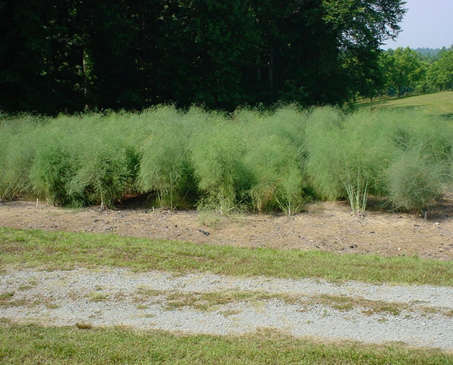
A comprehensive 66-page bulletin that covers the planting, growing, harvesting, and marketing of asparagus, including a budget with costs and expected income per acre, for the serious commercial asparagus grower. The bulletin includes several color photos of insects, diseases, and planting techniques to aid the grower. Written by an asparagus expert with over 30 years of applied research experience, enabling asparagus growers to become successful. To order your copy, send a check or money order for $25.00 to Carl Cantaluppi (includes postage) and mail to:
Carl Cantaluppi
1222 Grangers Rd.
Selinsgrove, PA 17870
Regional Reports
From north central Illinois...Despite being an annoying weed in my raised beds, seeing fields of blooming henbit is always a remarkable sight this time of year. During my travels two weeks ago, I was surprised to come across a planted field of corn in Morgan County. It seems our mild winter may bring an early corn/soybean crop, however, let us all keep in mind the year has just begun.
Our mild winter has been dry. Allowing lots of fieldwork before our past two weeks of recent rain. Cool season crops are in production, with our warm season transplants almost ready to go. A few growers have transplanted summer crops to high tunnels. Keeping high tunnel temperatures up with heat (usually wood fueled). Row covers are also a great tool for added protection in a high tunnel.
It seems we dodged the bullet on the cold snap two weeks ago. At the onset of our dip below freezing, temperatures started on Monday, March 6 at 70 degrees Fahrenheit and by Friday evening of that week, we hit 24 degrees. A few days later, our nighttime low hit 11 degrees. Some growers are reporting minimal to no damage to fruit tree buds. Some strawberries growers were not so lucky, with one farmer reporting complete loss of several rows of plasticulture strawberries. These particular rows were sited on a southwest exposure, but in a low spot creating a frost pocket of cold air. It goes to show how topography can play such an important role in microclimates. Meanwhile, many others reported their mulch kept the strawberries protected.
Peach trees are progressing through pink stage (prebloom), and will soon be in bloom. The nearby Golden Delicious apple tree is also approaching bloom.
Hops are emerging. Within the next couple of weeks, I will select the most vigorous hop shoots and train two to three per line. The hops will also receive nitrogen fertilizer at the time of pruning. This year my goal is to plant new hop rhizomes. For the past three years, Cascade has done well in my location. Centennial is next on my list.
Another experiment for this year is ginger and turmeric. I will be receiving the bare root shipment in the next few days. These non-traditional crops for the Midwest will be planted up in a greenhouse and transplanted to the high tunnel later in the season.
Chris Enroth (309-837-3939; cenroth@illinois.edu)
From east central Illinois...Farmers have concentrated on getting alliums and potatoes planted plus getting the last of their transplants seeded. Some farmers were able earlier in the month to prepare beds and lay plastic. This past week, it has been too wet to plant in fields and this is beginning to be a problem for some farmers with their early seeded cool season crops. Fruit trees are beginning to bloom and while some buds were killed by the low temperatures that hit the teens on March 14, 15 and 16, orchardists are still cautiously optimistic for a good crop.
Doug Gucker (217-877-6042; dgucker@illinois.edu)
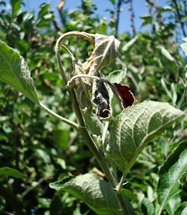
From the St. Louis Metro East... Typical spring weather in the region, warm and sunny one day, cold and rainy the next. Many of the trees are still bare, but more and more of the landscape is greening up. Most lawns have been mowed 2-3 times and the spring peepers can be heard chirping their familiar spring song. Field activity is delayed due to wet soil conditions. Bare soil temperatures at 4" is up to 60.3°F.
The majority of apples are in full bloom and temperatures and moisture in the region are conducive for fire blight bloom infection to occur. For complete details, visit Dr. Mohammad Babadoost's fire blight Report on Plant Disease at https://ipm.illinois.edu/diseases/rpds/801.pdf. Just as an added reminder, if you are using streptomycin, you must apply before a fire blight infection event (apples and pears) to reduce the incidence of fire blight. Streptomycin acts as a preventative/protectant and does not have curative activity. Although application of streptomycin before an infection event is greatly preferred and a better option, a rescue application applied within 24 hours after the infection event is your next option and still may provide some protection.
Elizabeth Wahle (618-344-4230; wahle@illinois.edu)
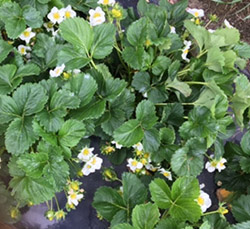
Photo by B. Aly
From southern Illinois...While we have had some reports of harvest of early season plasticulture strawberries (Sweet Charlie variety), the majority of the Chandler crop is past full bloom, with several small green fruits starting to size. Remember to keep up with the fungicide sprays, see your 2017 Midwest Fruit Pest Management Guide https://ag.purdue.edu/hla/Hort/Documents/ID-465.pdf , as timing of sprays, as well as good coverage, for diseases is critical. Spring rains can make spray applications challenging, especially if you are debating about making an application before or after a rain event or whether you have enough time to make a good application ahead of a rain. Read your labels to see how much drying time is recommended prior to a rain event.
Depending on the situation, a second application may be needed following a rain to ensure good coverage and control.
Bronwyn Aly (618-382-2662; baly@illinois.edu)
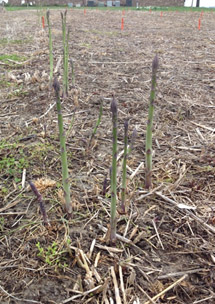
Photo: N. Johanning
From southern Illinois...We certainly have hit the "April showers" season. We have had multiple rain events the last week or so including Monday and today (Wednesday). Just this week we have had 1.25" and that is increasing as we speak. Temperatures have been in the 60s and 70s for highs with lows in the 50s. We are supposed to cool off later this week with highs back into the upper 50s for a few days and then more 60s and 70s. Lows are supposed to get into the low 40s to upper 30s the next few nights. I have heard of some chances of patchy frost, but nothing like the cold snap from a few weeks ago. We are supposed to be dry through the weekend after this system comes through, but more rain chances next week.
The rain has slowed field work especially on the vegetable side of things. Soils are fully saturated and it will take some good warm, windy, drying days before we can get in the fields to do any tillage work. Out in the field, apples and blueberries are starting to bloom. Asparagus harvest has started has just started on our variety trial with the first harvest being Monday (4/3). I did notice some asparagus beetles out in the patch, but only saw one spear that had a few eggs on it. I will be scouting closely and if more eggs are showing up, I will probably spray. For more information on asparagus beetle management refer to an article I wrote in Volume 22:6 from last year for some pictures and management practices.
Our high tunnel here in Murphysboro still has some lettuce and spinach, but we are in transition preparing for tomato and cucumber transplants coming in soon. As I have mentioned before with the warm February and March overall aphids have been an issue. Hopefully having a break with limited crops will prevent us from having as many aphid issues on our summer crops.
Nathan Johanning (618-939-3434; njohann@illinois.edu)
Fruit and Vegetable Production and Pest Management
Modified Growing Degree Days (Base 50°F, January 1 through April 2)
Insect development is temperature dependent. We can use degree days to help predict insect emergence and activity. Degree day accumulations calculated using the Illinois IPM Degree-Day Calculator (a project by the Department of Crop Sciences at the University of Illinois and the Illinois Water Survey).
Station Location |
Actual Total |
Historical Average (11 year) |
One- Week Projection |
Two-Week Projection |
|---|---|---|---|---|
Freeport |
73 |
40 |
90 |
117 |
St. Charles |
80 |
44 |
97 |
123 |
DeKalb |
83 |
49 |
103 |
132 |
Monmouth |
132 |
69 |
158 |
191 |
Peoria |
188 |
78 |
218 |
256 |
Champaign |
165 |
80 |
195 |
234 |
Springfield |
243 |
93 |
277 |
322 |
Perry |
244 |
105 |
278 |
322 |
Brownstown |
291 |
126 |
332 |
384 |
Belleville |
308 |
146 |
353 |
408 |
Rend Lake |
327 |
156 |
375 |
438 |
Carbondale |
336 |
161 |
383 |
443 |
Dixon Springs |
387 |
183 |
439 |
504 |
Kelly Estes, State Survey Coordinator, Illinois Cooperative Agricultural Pest Survey (217-333-1005; kcook8@illinois.edu)
Eutypa Management in Grapes
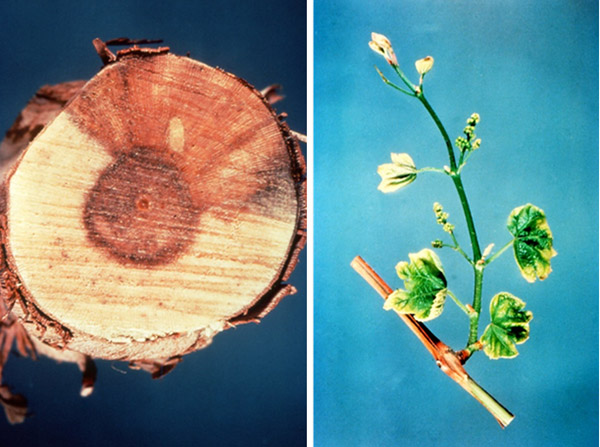
Eutypa is a grape disease growers need to scout for signs in infection regularly. Wood symptoms show up as sunken areas (cankers), typically on cordons or trunks near affected shoots. Cankers expand lengthwise in both directions from the wound and girdle and kill arms or trunks of infected vines in 5 to 10 years. It is common to find one side of a vine dead or with disease symptoms and the other side apparently healthy. Because freeze injury can cause identical wedge-shaped regions of dead wood, look for stunted shoots, which are a result of toxins produced by Eutypa. This is best seen in the spring, when shoots are 10 to 15 inches long. Leaves on shoots may be malformed, tattered, cupped and yellow (chlorotic). Remove symptomatic vines or prune out trunks, cordons, or spurs of symptomatic vines. Gather all infected wood and remove it from the vineyard or burn it. Be aggressive in your removal because there is no cure for the vine once it has become infected. Make your pruning cut at least 6" below the last visible canker edge. This fungus infects grape vines primarily through pruning wounds, which remain susceptible for a month or more (4-5 weeks).
Several growing seasons may elapse before visible cankers develop around an infected wound or before stunted shoot symptoms appear, allowing it to "sneak up" on growers. Scout for cankers below the bark, usually found surrounding an old pruning wound which can only be found by removing the rough outer bark. From cankers, the fungus releases spores once the bark has weathered off. Most spores are released during late winter and early spring when temperatures are above 32ºF and more than 1/25 inch rainfall or snowmelt occurs. Cultivar susceptibility to infection depends in part on when the pruning cuts are made. Pruning wounds made early in the dormant season are more susceptible to infection, in part because they can take weeks to 'heal.' Research has shown that vines pruned early in the winter, when they are dormant, do not heal as quickly and the pruning wounds are susceptible to infection for 4 to 5 weeks. In contrast, pruning wounds made late in the dormant season heal within days, and thus resist infection soon after pruning. Consider in the future delaying pruning until February-March. If this is not feasible, consider double pruning. Think of this as a type of delayed pruning where you make your 1st pass in December, leaving all canes ~8" or more in length. Make your 2nd and final pass in February or March. Because the pathogen grows slowly, it is unlikely to grow from the pruning wounds at the tips of the 8-inch canes down to the cordon in between the two pruning passes.
Elizabeth Wahle (618-344-4230; wahle@illinois.edu)
Cane and Crown Borers in Brambles
It has been a few years since information on cane and crown borers in brambles has been in the newsletter, so this is a good time to review the life cycles of the three common borers in brambles. Knowing the life cycle of these creatures will make you better informed so that you might be able to plan ahead and have greater success in monitoring and controlling in your plantings. The life cycle information below was taken from an article written by Dr. Rick Weinzierl in a previous IFVN issue.
Raspberry crown borer is a "clear-winged" moth and its larval stage is a caterpillar with fleshy abdominal prolegs that bear hook-like "crochets." It has a 2-year life cycle. Moths fly from August through September and lay their eggs on the undersides of leaves; eggs hatch in September and October and move down the canes to the crown. In their first fall, larvae form a hibernaculum below the soil line, then larvae girdle canes and crowns the next summer before wintering in the roots. They finish development and pupate in the second summer.
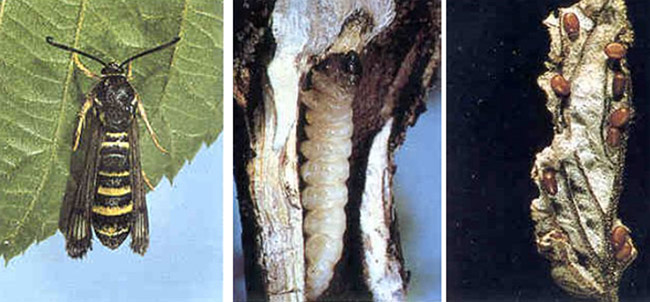
Raspberry crown borer adult, larva, and eggs.
Raspberry cane borer is a longhorned beetle; the larval stage is known as a round-headed wood borer. It also has a 2-year life cycle. Beetles feed on canes from June through August, and they lay eggs between rings of punctures on canes. Larvae tunnel to the base of canes by fall. They feed in crowns during their second summer, then pupate the following spring; adults emerge from June through August.

Raspberry cane borer adult, girdling and egg-laying puncture, wilted cane, and larva.
Rednecked cane borer is also a beetle, and the adult stage is known as a metallic wood boring beetle; larvae are called flat-headed wood borers. This insect has 1-year life cycle. Beetles feed on leaf margins from May through August and lay eggs in bark of new growth, usually within 10 inches of the base of canes. Larvae tunnel through canes and reach full size by fall. They pupate in the spring, and adults emerge in May. Damage is characterized by tunnels that spiral around the cane and by symmetrical swellings 1-4 feet above the soil line.
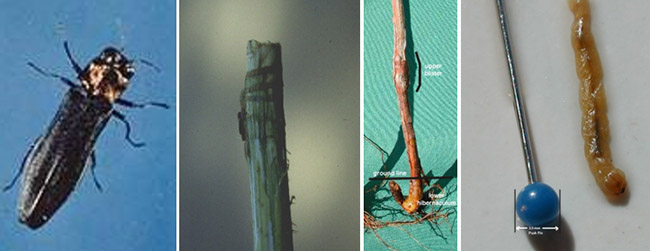
Rednecked cane borer adult, tunneling around cane, swelling of cane, and larva (third and fourth photos by Carl Lask).
Raspberry crown borer can be controlled by soil-drench applications of Brigade 2EC in October or early November or in March. Biological control by application of insect-pathogenic nematodes (Steinernema feltiae) also is possible. Removing infested crowns is also recommended. To control raspberry cane borer, prune out and destroy infested canes, beginning in July. Foliar sprays of insecticides labeled against other bramble pests (including Brigade and Sevin) give some control of adults from late May until mid July, but applications must be timed to avoid bee kill. Pruning out and destroying galled canes is also recommended for rednecked cane borer control. If more than 5% of canes are galled, postbloom application of Admire Pro to soil for systemic uptake and control may be warranted. Do not apply Admire Pro prebloom or during bloom. Brigade applied to the base of canes when adults are active will give some adult control ... again, remember to avoid bee kill.
For more information on these insects, check the Midwest Small Fruit Pest Management Handbook (http://estore.osu-extension.org/Midwest-Small-Fruit-Pest-Management-Handbook-P115.aspx ) and the 2017 Midwest Fruit Pest Management Guide (https://ag.purdue.edu/hla/Hort/Documents/ID-465.pdf ), specifically pages 111-117 address raspberry and blackberry pests.
Bronwyn Aly (618-382-2662; baly@illinois.edu)
Backpack Sprayer Use
Small vegetable growers may find pesticide applications with a tractor driven sprayers impractical. Such growers may turn to hand sprayers. In this article, I will discuss the use and calibration of a backpack sprayer, an excellent alternative to a garden sprayer for small growers. The remainder of this article will discuss one method of calibrating a backpack sprayer.
Most pesticides are labeled for use on an area basis, typically an acre. Therefore, the first task in calibration is to measure the area to be treated. Let's say that tomatoes are grown in a greenhouse where the production covers 30 X 100 feet = 3,000 square feet. For our staked tomato example, we will use a volume-based method of pesticide measurement. For this method:
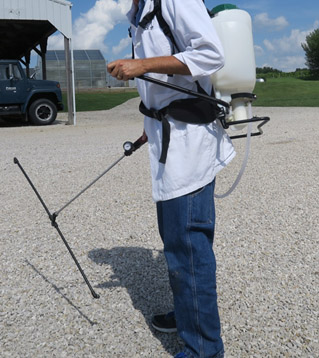
- Determine the volume of water required to cover the fully-grown crop on an acre-basis. See discussion later.
- Mix the acre rate (or portion of an acre) of the particular pesticide to be applied in the volume of water determined in step 1.
- Apply the mixed pesticide to the plants.
For example, if Dithane F45 is labeled at 2.4 quarts per acre, and it takes 100 gallons of water per acre to adequately cover mature staked tomatoes, mix 2.4 quarts in 100 gallons for an acre of staked tomatoes. Now, let's calculate the pesticide rate for our greenhouse example.
Since we calculated the size of our greenhouse production as 3,000 square feet, we can figure the proportion of acre of our production. 3,000 square feet/43560 square feet per acre = 0.07 acres.
Next, we must consult the label to determine how much product to apply per acre. Let's say we want to apply Dithane F45, which is labeled for tomatoes in the greenhouse at 2.4 quarts per acre. How much should we measure for our tomato greenhouse example?
0.07 acres of greenhouse tomatoes x 2.4 quarts/acre labeled rate = 0.17 quarts for greenhouse example (Since there are 32 fl. oz in a quart, we have 0.17 x 32 = 5.5 fl. oz).
Next we must determine how much water to use with 5.5 fl. oz. of product in our backpack sprayer. Therefore, we must calibrate our sprayer. Let's break this down into a few steps.
- Measure off a portion of the area to be treated. For our greenhouse example, we will measure 60 feet for calibration purposes. Since we have 6 rows of tomatoes at 100 feet each we have 600 linear feet of tomatoes. (We are using for calibration a tenth of the total area to be treated).
- Fill your sprayer with a known amount of water. We will put one gallon (128 fl. oz.) of water in our sprayer.
- Spray the water onto the calibration area.
- The person who will be doing the spraying should be the one doing the calibration.
- If the person or equipment changes, then the calibration needs to be re-done.
- The walking pace needs to be constant.
- After the 60 feet of tomatoes has been sprayed completely (did you spray both sides of your staked tomatoes?), dump out the left-over water into a measuring device. In our example, we had 96 ounces of water left (128-96=32 fl. oz.). Therefore, 32 ounces of water was applied on 60 linear feet. How much water would we need for the entire greenhouse (600 linear feet of tomato)?
Multiply 32 fl. oz. of water that was applied on our calibration area x 10 to equal the total area to be treated. Therefore, we need to add our 5.5 fl. oz. of Dithane F45 in 320 fl. oz. of water or 2.5 gallons of water. That is, it will take 2.5 gallons to cover our tomatoes in the greenhouse example.
Here are a few other items to consider.
- It is best to repeat the calibration a few times to make sure that amount of water applied is accurate.
- The pace that is used in walking on the product must remain constant throughout the entire area and from application to application. It might help to keep in mind a particular piece of music or use a mechanical metronome to keep a constant pace.
- As the crop grows, it may be best to use a different number of nozzles on the boom. For example, at the start of the season one might use 2 nozzles while blocking off the remaining nozzles. When extra nozzles are used, the system must be re-calibrated.
- In the example above, we used 2.5 gallons of water on 0.07 acres. Since 3000 sq. ft. is about 1/14th of an acre that works out to be about 35 gallons per acre of water (2.5 gallons X 14). In general it is best to keep the water per acre amounts to 20 gallons or more. The idea is to thoroughly wet the plant tissue. In most cases, one does not want run off.
The example above is for a liquid fungicide. If instead the fungicide is a dry formulation, then the calculation might go like this: Penncozeb at 2 lb/acre x 0.07 acres = 0.14 lb. (2.25 oz).
How to measure out a dry oz? Don't measure out the Penncozeb in a measuring cup designed for liquids. Weigh the 2.25 oz on a kitchen scale or on some other appropriate scale. Pesticides that are given in fluid ounces should be measured in measuring cup-like devices; pesticides that are given in dry ounces must be measured on a scale. For example, a kitchen scale that may purchased at a well-known box store for about $10 can be used for weighing out dry pesticides. When we used a liquid measuring device for Penncozeb, the amount of Penncozeb was underestimated by 20%!
There are other methods of sprayer calibration. The important point is to spend time calibrating your sprayer equipment, whatever method you use. Proper calibration takes time, but must be done if pesticides are to be applied properly.
Dan Egel, Extension Plant Pathologist, Purdue Vegetable Crops Hotline, Purdue University (812-886-0198; egel@purdue.edu)
Less Seriously...
http://humormatters.com/holidays/easter.htm
All I Need to Know About Life I Learned from the Easter Bunny
Don't put all of your eggs in one basket.
Walk softly and carry a big carrot.
Everyone needs a friend who is all ears.
There's no such thing as too much candy.
All work and no play can make you a basket case.
A cute little tail attracts a lot of attention.
Everyone is entitled to a bad hare day.
Let happy thoughts multiply like rabbits.
Some body parts should be floppy.
Keep your paws off other people's jellybeans.
The grass is always greener in someone else's basket.
An Easter bonnet can tame even the wildest hare.
To show your true colors you have to come out of your shell.
The best things in life are still sweet and gooey!
University of Illinois Extension Specialists in Fruit and Vegetable Production & Pest Management
Extension Educators – Local Food Systems and Small Farms |
||
Bronwyn Aly, Gallatin, Hamilton, Hardin, Pope, Saline, and White counties |
618-382-2662 |
|
Katie Bell, Franklin, Jackson, Perry, Randolph, & Williamson counties |
618-687-1727 |
|
Sarah Farley, Lake & McHenry counties |
847-223-8627 |
|
Nick Frillman, Woodford, Livingston, & McLean counties |
309-663-8306 |
|
Laurie George, Bond, Clinton, Jefferson, Marion, & Washington counties |
618-548-1446 |
|
Zachary Grant, Cook County | 708-679-6889 | |
Doug Gucker, DeWitt, Macon, and Piatt counties |
217-877-6042 |
|
Erin Harper, Champaign, Ford, Iroquois, and Vermillion counties |
217-333-7672 |
|
Grace Margherio, Jackie Joyner-Kersee Center, St. Clair County |
217-244-3547 |
|
Grant McCarty, Jo Daviess, Stephenson, and Winnebago counties |
815-235-4125 |
|
Katie Parker, Adams, Brown, Hancock, Pike and Schuyler counties |
217-223-8380 |
|
Kathryn Pereira, Cook County |
773-233-2900 |
|
James Theuri, Grundy, Kankakee, and Will counties |
815-933-8337 |
|
Extension Educators – Horticulture |
||
Chris Enroth, Henderson, Knox, McDonough, and Warren counties |
309-837-3939 |
|
Richard Hentschel, DuPage, Kane, and Kendall counties |
630-584-6166 |
|
Andrew Holsinger, Christian, Jersey, Macoupin, & Montgomery counties |
217-532-3941 |
|
Extension Educators - Commercial Agriculture |
||
Elizabeth Wahle, Fruit & Vegetable Production |
618-344-4230 |
|
Nathan Johanning, Madison, Monroe & St. Clair counties |
618-939-3434 |
|
Campus-based Extension Specialists |
||
Kacie Athey, Entomology |
217-244-9916 |
|
Mohammad Babadoost, Plant Pathology |
217-333-1523 |
|